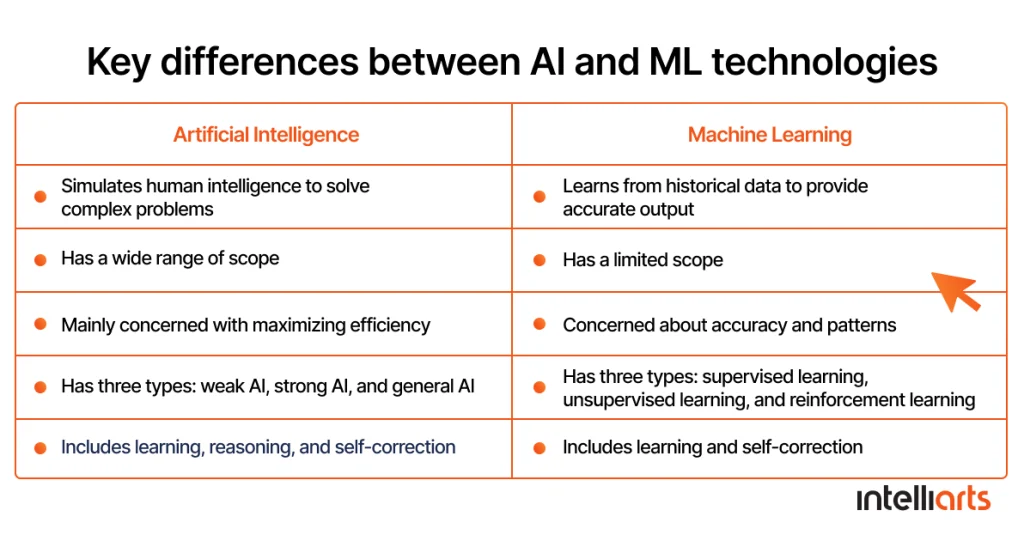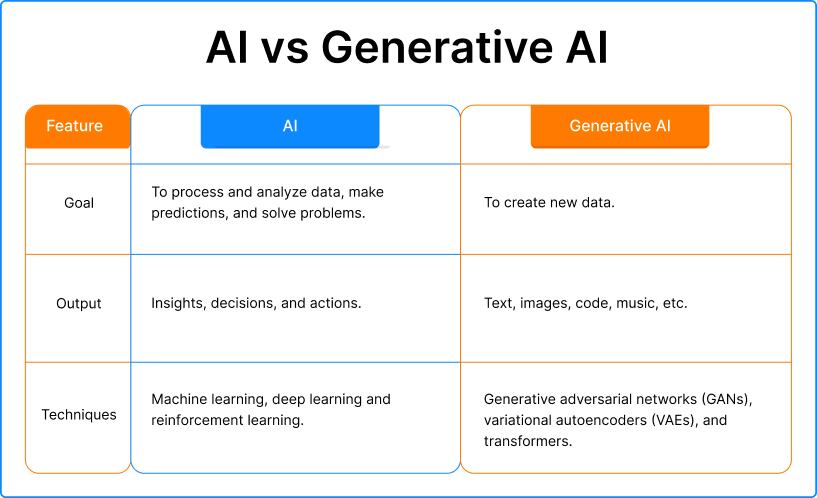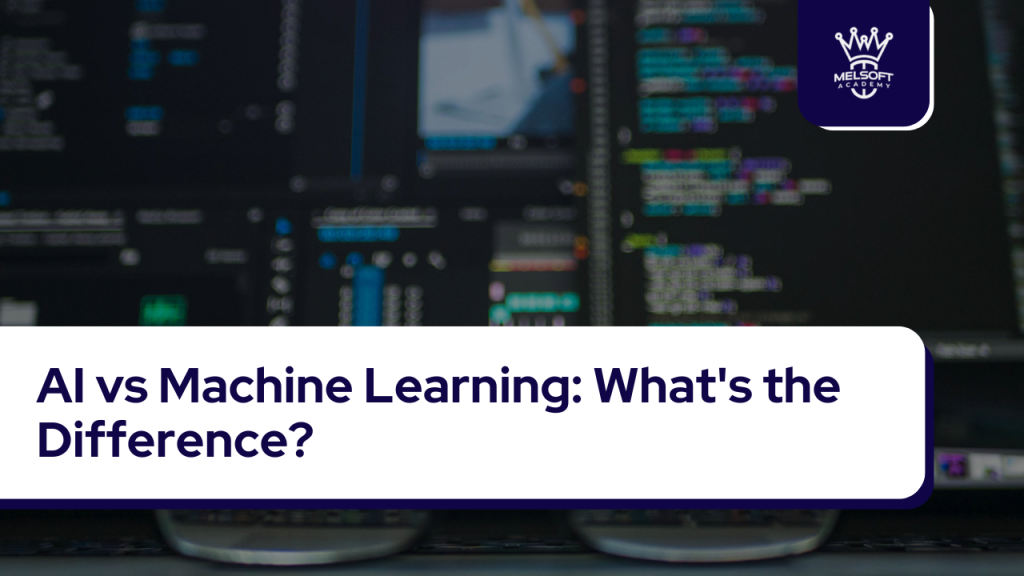You’re likely immersed in a world increasingly dominated by technological advancements, constantly encountering terms like artificial intelligence (AI), machine learning (ML), deep learning, and neural networks. These buzzwords, while exciting, can be confusing, even for tech professionals.
This comprehensive guide will demystify the relationship between AI and machine learning, clarifying their distinctions and exploring their vast applications across numerous industries. We’ll delve into the core differences, examine subsets of AI, and explore the practical implications of both technologies. By the end, you’ll have a clear understanding of how AI and ML are shaping our world and the potential they hold for the future.
Key Takeaways:
- AI is a broad field encompassing the creation of intelligent machines capable of performing human-like tasks.
- Machine learning is a subset of AI that focuses on enabling systems to learn from data without explicit programming.
- The key difference lies in their approach: AI aims to mimic human intelligence, while ML focuses on enabling systems to learn and improve from data.
- Both AI and ML are transforming various industries, driving innovation and efficiency.
- Understanding the nuances of AI and ML is crucial for navigating the rapidly evolving technological landscape.
What is Artificial Intelligence?
Artificial intelligence (AI) is a vast field of computer science dedicated to creating intelligent machines capable of performing tasks that typically require human intelligence. Think about tasks like visual perception—allowing a computer to “see” and interpret images—speech recognition (understanding spoken language), decision-making (making choices based on available information), and language translation (converting text from one language to another). These are all areas where AI strives to replicate or surpass human capabilities.
AI encompasses a wide array of technologies and approaches, with machine learning being one of its most prominent subsets. The overarching goal of AI is to create systems that can reason, learn, and solve problems in a way that mimics human cognitive functions. The history of AI stretches back to the 1950s, with researchers initially focusing on symbolic reasoning and rule-based systems. However, the field has evolved dramatically, leading to the sophisticated AI models and applications we see today, including advancements in deep learning and neural networks. Learn more about the history of AI.
What is Machine Learning?
Machine learning (ML), a core subset of AI, focuses on enabling computer systems to learn from data without being explicitly programmed. Instead of relying on pre-defined rules, ML algorithms identify patterns, make predictions, and improve their performance over time based on the data they are exposed to. This learning process allows ML models to adapt to new data and improve their accuracy without human intervention.
There are various types of machine learning, including supervised learning (where the algorithm learns from labeled data), unsupervised learning (where the algorithm identifies patterns in unlabeled data), and reinforcement learning (where the algorithm learns through trial and error). The choice of algorithm depends on the specific task and the nature of the available data. Explore different machine learning algorithms. (Replace with a relevant link to an appropriate resource)
AI vs Machine Learning: Key Differences – Understanding the Scope

Machine Learning in The Insurance Sector [Top 7 Use Cases]
While machine learning is a subset of AI, the difference lies in their scope and approach. AI aims to create systems that can mimic human intelligence in its entirety, encompassing a broader range of capabilities. Machine learning, on the other hand, focuses on a specific aspect of intelligence: the ability to learn from data.
Think of it this way: AI is the overarching goal—creating intelligent machines—while machine learning is one of the many tools or techniques used to achieve that goal. You could build an AI system that doesn’t use machine learning, relying instead on rule-based systems or other approaches. However, most modern AI systems leverage machine learning to achieve their intelligent behavior.
Subsets of AI: Beyond Machine Learning
AI encompasses a broader spectrum of techniques beyond machine learning. Some key subsets include:
- Expert Systems: These systems mimic the decision-making ability of a human expert in a specific domain. They use a knowledge base of rules and facts to provide advice or make recommendations.
- Natural Language Processing (NLP): This focuses on enabling computers to understand, interpret, and generate human language. Applications include chatbots, language translation, and sentiment analysis.
- Computer Vision: This involves enabling computers to “see” and interpret images and videos, similar to human vision. Applications include object recognition, image classification, and facial recognition.
- Robotics: This combines AI with physical robots to create autonomous systems capable of performing tasks in the real world.
AI and Machine Learning in Practice: Real-World Applications
Both AI and ML are transforming industries at an unprecedented pace. Here are some examples:
- Healthcare: AI and ML are used for disease diagnosis, drug discovery, personalized medicine, and robotic surgery.
- Finance: AI powers fraud detection, algorithmic trading, risk management, and customer service chatbots.
- Retail: AI and ML personalize recommendations, optimize pricing, and improve supply chain management.
- Transportation: Self-driving cars rely heavily on AI and ML for navigation, object detection, and decision-making.
Generative AI vs Machine Learning: A Deeper Dive

Generative AI vs Machine Learning
Generative AI is a rapidly evolving subset of AI that focuses on creating new content, such as text, images, audio, and video. Unlike traditional machine learning models that primarily focus on prediction or classification, generative AI models learn the underlying patterns in data and then use this knowledge to generate new, similar data. Examples include models that can generate realistic images, write compelling stories, or compose music. While generative AI leverages many machine learning techniques, its focus on content creation distinguishes it from other ML applications.
What is an AI Model vs an ML Model?
The terms “AI model” and “ML model” are often used interchangeably, but there’s a subtle distinction. An ML model is a specific algorithm trained on data to perform a particular task, such as classification or prediction. An AI model is a broader term that can encompass ML models but also includes other AI techniques, such as rule-based systems or expert systems. Essentially, all ML models are AI models, but not all AI models are ML models.
FAQs
Q: Is machine learning the same as deep learning?
A: No, deep learning is a subset of machine learning that uses artificial neural networks with multiple layers (hence “deep”) to analyze data. While all deep learning is machine learning, not all machine learning is deep learning.
Q: What are the ethical considerations of AI and ML?
A: The rapid advancement of AI and ML raises several ethical concerns, including bias in algorithms, job displacement, privacy violations, and the potential misuse of these technologies. Responsible development and deployment of AI and ML require careful consideration of these ethical implications.
Q: How can I get started learning AI and ML?
A: Start with the basics by learning programming languages like Python, understanding fundamental statistical concepts, and exploring online courses and tutorials. There are numerous free and paid resources available to help you begin your journey.
Q: What are the future trends in AI and ML?
A: Future trends include advancements in deep learning, explainable AI (making AI decisions more transparent), the rise of edge AI (processing data closer to the source), and the increasing integration of AI and ML into various aspects of our lives.
This comprehensive guide provides a foundational understanding of the differences between AI and machine learning. As you continue your exploration of these fields, remember that the lines between them are often blurred, and the synergy between AI and ML is driving innovation across numerous industries. The future of technology hinges on these powerful technologies, and understanding their capabilities is essential for navigating the rapidly evolving technological landscape.
Download our prospectus: Download Prospectus
About Melsoft Academy: Learn More
Apply Now: Apply Here
Apply to the Manati Alternate Student Funding: Apply for Funding



I think this is among the most vital info for me.
And i am glad reading your article. But should remark on some general things,
The website style is perfect, the articles is really excellent :
D. Good job, cheers
Thanks a bunch for sharing this with all of us you actually recognize what you’re
speaking about! Bookmarked. Kindly also seek advice from my web site
=). We could have a hyperlink exchange contract among us
Thank you, I’ve recently been looking for info about this subject for a while and yours is the best I have found out so far.
But, what concerning the conclusion? Are you positive concerning the source?